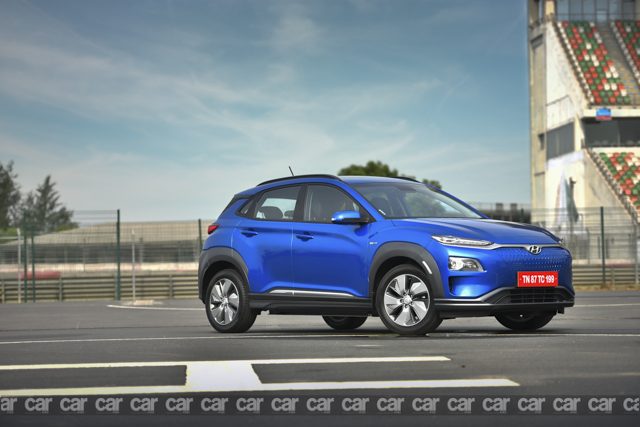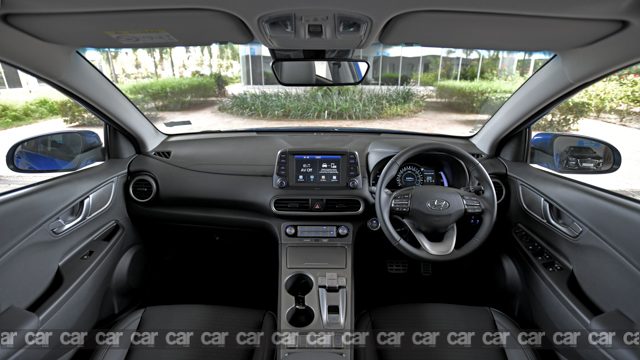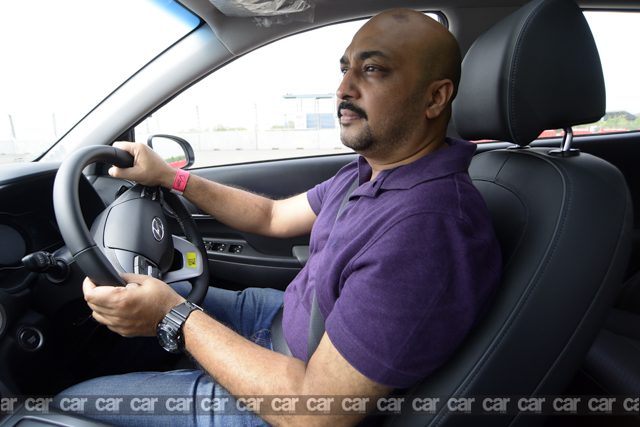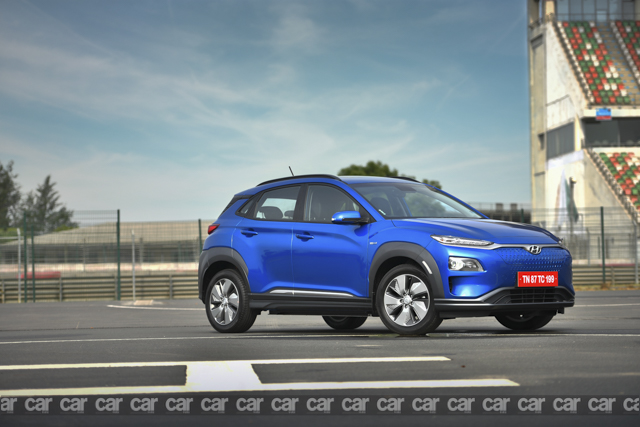We drive the Hyundai Kona Electric, Hyundai Motor India’s first long-range all-electric SUV at Buddh International Circuit
Design
It looks like a contemporary mid-sized crossover, about the size of a Hyundai Creta. The design of the Kona is not striking but is unique enough to get an approving second glance.

Being an EV, the Hyundai Kona Electric doesn’t require a front grille and to give a familiar face, the engineers have etched the large front bumper to impersonate Hyundai’s signature hexagonal grille. It also conceals the charging socket which is hidden underneath a small flush-finished lid. The headlamps are mounted low on the single-piece bumper, while the sleek LED daytime running lights are positioned above making it an eye-catching design. It’s only when you look at it from rear three-quarters does the Kona appear more robust and SUV-ish. The high roofline, pronounced rear wheel arches and the plastic cladding add up to give it a more robust appearance. The rear styling gets the usual Hyundai treatment with slim LED tail lamps and a curvaceous boot lid. (Also Read: Hyundai Kona Electric Launch in India)
[metaslider id=”23078″]
Cabin and interior
When you get inside the Hyundai Kona Electric, you’re greeted by a neat looking cabin. You can’t complain about the quality and finish, but considering the car’s asking price it doesn’t feel as premium. The buttons and knobs seem well built and feel good to use. There are loads of features including ventilated seats, wireless phone charger, driving modes and the 7-inch infotainment system with Apple CarPlay and Android Auto. Using the EV menu screen you can get data about Eco-driving, power consumption and charge management. Interesting creature comfort includes a driver-only air-con option which keeps only the blower near the driver on and saves precious energy. (Also Read: MG Hector India Launch)

The front seats are comfortably large and provide decent all-round support. The driver’s seat is powered with 10-way adjustable. The rear bench, in comparison, isn’t as supportive. This is because the floorboard is higher than usual due to the battery pack underneath. This rob the seats of the desired under-thigh support. You might not even notice it on short city drives but may become obvious if you try to test the battery range.
Powertrain and Range
Like we mentioned in our previous drive report of the Hyundai Kona Electric, India gets the smaller 136 PS, 39.2 kWh lithium-ion battery with a 100kW motor that powers the front wheels. Internationally, it is said to have a range of about 289 km but here due to the different testing cycle of ARAI the electric-SUV claims to run for 452 kilometres on a full charge. In real-world conditions, expect a range of a reassuring 225 km approximately, which take care of the usual range anxiety.
For the price, you get two charging kits with Hyundai Kona Electric. A basic 2.8 kW portable cable charger which can be plugged into a standard electric socket takes about 19 hours for a full charge. Apart from this you also get a Rs 70,000 worth 7.2 kW AC box charger that can be mounted to your garage wall and takes about 6 hours to juice-up the Hyundai Kona Electric completely. The latter takes just an hour to provide a charge to last for 50 kilometres.
Driving Dynamics
Thankfully, the Hyundai Kona Electric I was testing had enough charge for me to pit it against India’s premium race track – the Buddh International Circuit. I dab on the D for the drive button to engage the single-speed reduction gearbox. The best thing about an electric car on a race track is that it delivers instant surge. The entire 395 Nm of torque is at your service from the moment you’ve selected the Drive mode. No turbo lag, no gear shifts, just heap full of linear propulsion and a whizzing electric motor. And faint tyre noise and nothing else. The feeling is surreal and a complete contrast to IC cars I’ve driven at BIC earlier.
The Hyundai Kona Electric gets four driving modes Eco, Eco Plus, Comfort and Sport. Eco Plus is by far the most efficient. For an electric car, this one drives surprisingly well and feels peppy enough at city speeds. Hyundai Kona Electric claims a 0-100 km/h time of 9.7 seconds and we hope to test it once we get some more time with the e-SUV. (Also Read: Audi e-tron 55 quattro First Drive Review)

Ride and Handling
The handling is like other Hyundai hatchbacks available in the market. It’s light and effortless to use with decent feedback, though lacking a bit in terms of feel. The suspension on the smooth tarmac of the racetrack didn’t feel too soft and helped restrain
Our short track drive experience of the Hyundai Kona Electric got over rather quickly. Rolling into the pit-lane I anchored the Kona using the steering-mounted paddle-shifters that manage the brake energy regen. To think of it, this can be a pretty good everyday city car with zero-emission and low running cost.
Hyundai




















Leave a Reply